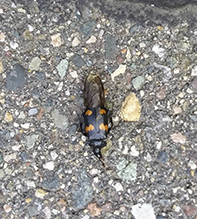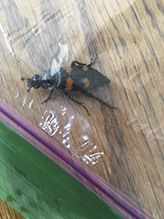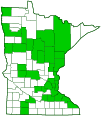roundneck sexton beetle
(Nicrophorus orbicollis)
Conservation • Description • Habitat • Ecology • Distribution • Taxonomy
Conservation Status |
|
|||||||
| IUCN Red List | not listed |
|||||||
| NatureServe | NNR - Unranked |
|||||||
| Minnesota | not listed |
|||||||
Description |
||
Roundneck sexton beetle is common, large, burying beetle. It occurs throughout the eastern United States and in southern Canada, and in a few widely separated areas in the west. It is active from late May to October but most active in the hot summer months from June to August. It is usually found in deciduous forests and woodlands, but also in grasslands. Adults feed mostly on the feces of carnivores, including humans, but also on carrion, maggots, and rotting fruit. Roundneck sexton beetle adult is ⅝″ to ⅞″ (15 to 22 mm) long. The body is moderately robust, elongate, somewhat flattened, and mostly black. The underside is covered with brown hairs. The head and mouth parts are projected forward. The antennae are black and are abruptly widened at the tip (clubbed). They have 11 segments but the second segment is very small, making it appear that there are only 10 segments. The expanded portion of the club is mostly bright orange, black just at the base. It is covered with velvety hairs (setae). The hardened plate covering the thorax (pronotum) is nearly round and entirely black with no orange markings. It is sharply flattened at the edges with broad margins at the sides and base. The plate between the wing bases (scutellum) is visible, moderate-sized, and entirely black. The hardened wing covers (elytra) are truncate, appearing cut off at the tip and exposing 2 or 3 body segments. They are covered with long erect hairs. The lateral margins are folded under and are entirely black. The surface is smooth, not ridged. There are two pairs of orange markings on the elytra. The front pair is long and broadly jagged. The rear pair is smaller and more circular but still jagged. The shape of the elytral markings is a key identifying feature for each species within this genus. The legs are black. The fourth segment (tibia) on each hind leg is straight, not curved. The end part of each leg (tarsus), corresponding to the foot, has 5 segments. |
||
Size |
||
Total length: ⅝″ to ⅞″ (15 to 22 mm) |
||
Similar Species |
||
Habitat |
||
Mostly woodlands |
||
Ecology |
||
Season |
||
Late May to October |
||
Behavior |
||
After finding a carcass, the male will emit pheromones to attract a female. Together they will bury the carcass to keep it moist and prevent it being taken by a scavenger. Both adults feed the larvae. Adults are attracted to light. |
||
Life Cycle |
||
The female lays eggs close to the buried carcass. After they hatch the first stage (instar) larvae are fed by the adults. The adults overwinter. |
||
Larva Food |
||
Decaying flesh regurgitated by the adults. |
||
Adult Food |
||
Mostly feces of carnivores, including humans, but also carrion, maggots, and rotting fruit. |
||
Distribution |
||||
|
Sources |
|||
| 8/9/2023 | ||||
Occurrence |
||||
Common |
||||
Taxonomy |
|||
Order |
Coleoptera (Beetles) | ||
Suborder |
Polyphaga (Water, Rove, Scarab, Long-horned, Leaf, and Snout Beetles) | ||
Infraorder |
Staphyliniformia | ||
Superfamily |
Staphylinoidea (rove, ant-like stone, and carrion beetles) | ||
Family |
Silphidae (burying and carrion beetles) | ||
Subfamily |
Nicrophorinae | ||
Genus |
Nicrophorus (burying beetles) | ||
Synonyms |
|||
|
|||
Common Names |
|||
roundneck sexton beetle |
|||
Glossary
Elytra
The hardened or leathery forewings of beetles used to protect the fragile hindwings, which are used for flying. Singular: elytron.
Pronotum
The exoskeletal plate on the upper side of the first segment of the thorax of an insect.
Scutellum
The exoskeletal plate covering the rearward (posterior) part of the middle segment of the thorax in some insects. In Coleoptera, Hemiptera, and Homoptera, the dorsal, often triangular plate behind the pronotum and between the bases of the front wings. In Diptera, the exoskeletal plate between the abdomen and the thorax.
Seta
A stiff, hair-like process on the outer surface of an organism. In Lepidoptera: A usually rigid bristle- or hair-like outgrowth used to sense touch. In mosses: The stalk supporting a spore-bearing capsule and supplying it with nutrients. Plural: setae. Adjective: setose.
Tarsus
On insects, the last two to five subdivisions of the leg, attached to the tibia; the foot. On spiders, the last segment of the leg. Plural: tarsi.
Tibia
The fourth segment of an insect leg, after the femur and before the tarsus (foot). The fifth segment of a spider leg or palp. Plural: tibiae.
Visitor Photos |
|||||
Share your photo of this insect. |
|||||
| This button not working for you? Simply email us at info@MinnesotaSeasons.com. Attach one or more photos and, if you like, a caption. |
|||||
Luciearl |
|||||
 |
|||||
Steve Murray |
|||||
 |
|||||
MinnesotaSeasons.com Photos |
|||||
|
|||||

Visitor Videos |
|||
Share your video of this insect. |
|||
| This button not working for you? Simply email us at info@MinnesotaSeasons.com. Attach a video, a YouTube link, or a cloud storage link. |
|||
Other Videos |
|||
| Nicrophorus orbicollis round neck sexton beetle Outside in Georgia |
|||
About
Aug 1, 2019 |
|||
| Burying Beetle (Silphidae: Nicrophorus orbicollis) Lateral View Carl Barrentine |
|||
About
Aug 27, 2011 Photographed at the Turtle River State Park, North Dakota (26 August 2011). |
|||
| Beetles Eating Toad Frog Burying Beetle Nicrophorus orbicollis Chimney Rock NC bugs feeding José da Vēde • Composer |
|||
About
Dec 19, 2012 The Burying Beetles are widespread throughout the North America. They feed on small animal carcasses, which the males using to attract a mate. The male releases pheromones once carcass is found. They will fight to the death with other males, but once order is established, a single male and female mate and bury the carcass together, sharing equally with the work load. Females then lay eggs nearby, which the larvae will use for nourishment. If the carcass is too big multiple beetles will be allowed. |
|||

Created: 7/5/2020
Last Updated:





